Caspase信号通路
细胞凋亡的原理
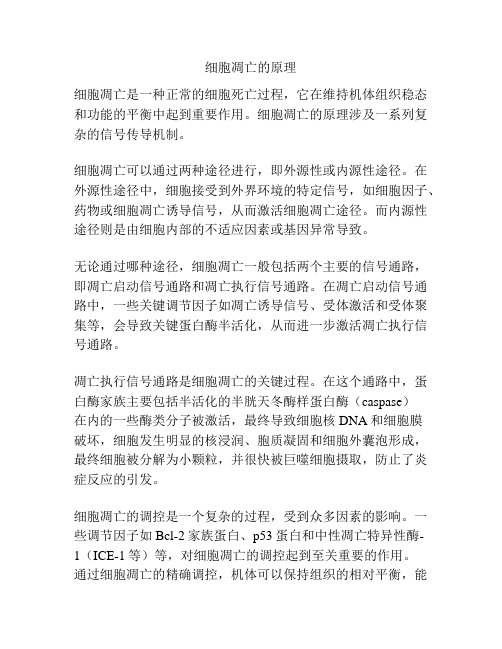
细胞凋亡的原理
细胞凋亡是一种正常的细胞死亡过程,它在维持机体组织稳态和功能的平衡中起到重要作用。
细胞凋亡的原理涉及一系列复杂的信号传导机制。
细胞凋亡可以通过两种途径进行,即外源性或内源性途径。
在外源性途径中,细胞接受到外界环境的特定信号,如细胞因子、药物或细胞凋亡诱导信号,从而激活细胞凋亡途径。
而内源性途径则是由细胞内部的不适应因素或基因异常导致。
无论通过哪种途径,细胞凋亡一般包括两个主要的信号通路,即凋亡启动信号通路和凋亡执行信号通路。
在凋亡启动信号通路中,一些关键调节因子如凋亡诱导信号、受体激活和受体聚集等,会导致关键蛋白酶半活化,从而进一步激活凋亡执行信号通路。
凋亡执行信号通路是细胞凋亡的关键过程。
在这个通路中,蛋白酶家族主要包括半活化的半胱天冬酶样蛋白酶(caspase)
在内的一些酶类分子被激活,最终导致细胞核DNA和细胞膜
破坏,细胞发生明显的核浸润、胞质凝固和细胞外囊泡形成,最终细胞被分解为小颗粒,并很快被巨噬细胞摄取,防止了炎症反应的引发。
细胞凋亡的调控是一个复杂的过程,受到众多因素的影响。
一些调节因子如Bcl-2家族蛋白、p53蛋白和中性凋亡特异性酶-
1(ICE-1等)等,对细胞凋亡的调控起到至关重要的作用。
通过细胞凋亡的精确调控,机体可以保持组织的相对平衡,能
够清除老化、受损或异常细胞,同时也能够对病原体和恶性细胞做出反应。
细胞凋亡的信号转导机制
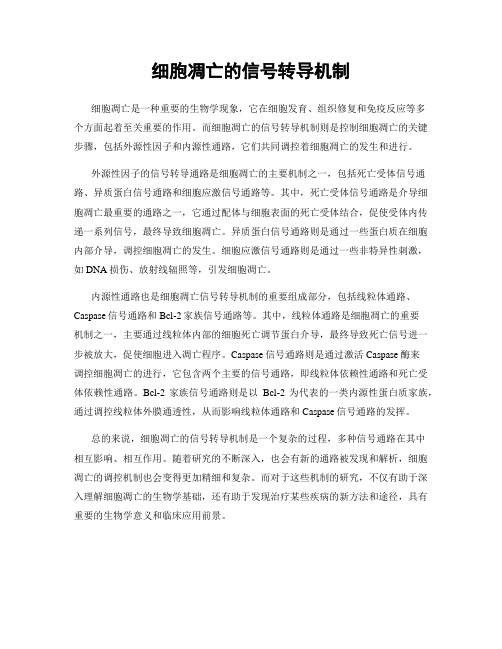
细胞凋亡的信号转导机制细胞凋亡是一种重要的生物学现象,它在细胞发育、组织修复和免疫反应等多个方面起着至关重要的作用。
而细胞凋亡的信号转导机制则是控制细胞凋亡的关键步骤,包括外源性因子和内源性通路,它们共同调控着细胞凋亡的发生和进行。
外源性因子的信号转导通路是细胞凋亡的主要机制之一,包括死亡受体信号通路、异质蛋白信号通路和细胞应激信号通路等。
其中,死亡受体信号通路是介导细胞凋亡最重要的通路之一,它通过配体与细胞表面的死亡受体结合,促使受体内传递一系列信号,最终导致细胞凋亡。
异质蛋白信号通路则是通过一些蛋白质在细胞内部介导,调控细胞凋亡的发生。
细胞应激信号通路则是通过一些非特异性刺激,如DNA损伤、放射线辐照等,引发细胞凋亡。
内源性通路也是细胞凋亡信号转导机制的重要组成部分,包括线粒体通路、Caspase信号通路和Bcl-2家族信号通路等。
其中,线粒体通路是细胞凋亡的重要机制之一,主要通过线粒体内部的细胞死亡调节蛋白介导,最终导致死亡信号进一步被放大,促使细胞进入凋亡程序。
Caspase信号通路则是通过激活Caspase酶来调控细胞凋亡的进行,它包含两个主要的信号通路,即线粒体依赖性通路和死亡受体依赖性通路。
Bcl-2家族信号通路则是以Bcl-2为代表的一类内源性蛋白质家族,通过调控线粒体外膜通透性,从而影响线粒体通路和Caspase信号通路的发挥。
总的来说,细胞凋亡的信号转导机制是一个复杂的过程,多种信号通路在其中相互影响、相互作用。
随着研究的不断深入,也会有新的通路被发现和解析,细胞凋亡的调控机制也会变得更加精细和复杂。
而对于这些机制的研究,不仅有助于深入理解细胞凋亡的生物学基础,还有助于发现治疗某些疾病的新方法和途径,具有重要的生物学意义和临床应用前景。
细胞凋亡的信号通路
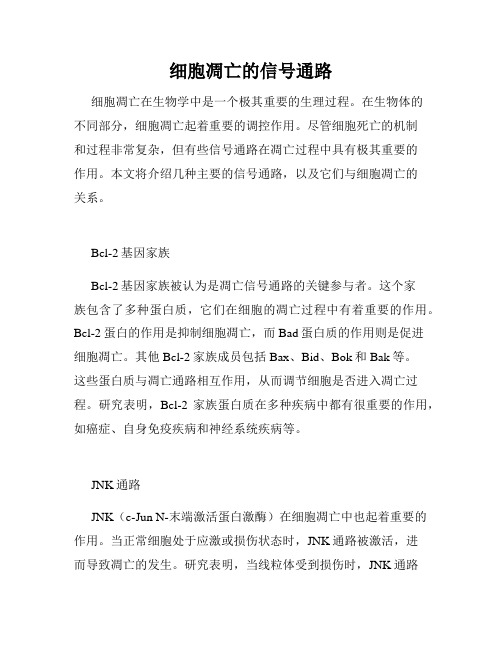
细胞凋亡的信号通路细胞凋亡在生物学中是一个极其重要的生理过程。
在生物体的不同部分,细胞凋亡起着重要的调控作用。
尽管细胞死亡的机制和过程非常复杂,但有些信号通路在凋亡过程中具有极其重要的作用。
本文将介绍几种主要的信号通路,以及它们与细胞凋亡的关系。
Bcl-2基因家族Bcl-2基因家族被认为是凋亡信号通路的关键参与者。
这个家族包含了多种蛋白质,它们在细胞的凋亡过程中有着重要的作用。
Bcl-2蛋白的作用是抑制细胞凋亡,而Bad蛋白质的作用则是促进细胞凋亡。
其他Bcl-2家族成员包括Bax、Bid、Bok和Bak等。
这些蛋白质与凋亡通路相互作用,从而调节细胞是否进入凋亡过程。
研究表明,Bcl-2家族蛋白质在多种疾病中都有很重要的作用,如癌症、自身免疫疾病和神经系统疾病等。
JNK通路JNK(c-Jun N-末端激活蛋白激酶)在细胞凋亡中也起着重要的作用。
当正常细胞处于应激或损伤状态时,JNK通路被激活,进而导致凋亡的发生。
研究表明,当线粒体受到损伤时,JNK通路也会被激活。
这些结果表明JNK通路在响应细胞应激、损伤和细胞死亡等方面具有很重要的作用。
因此,在研究和治疗许多疾病时,JNK通路都是一个非常重要的治疗靶点。
Caspase通路Caspase是一类重要的凋亡相关蛋白质,在细胞凋亡中发挥重要的作用。
Caspase通路的激活是细胞凋亡发生的最重要的步骤之一。
在凋亡通路中,Caspase经常会被序列激活,从而引发一系列的凋亡反应。
研究发现,Caspase在神经细胞的凋亡中具有非常重要的作用,而且在许多人类疾病中也起着极其重要的作用。
因此,Caspase通路也成为了研究急性损伤和慢性疾病治疗的一个重要领域。
MAPK通路MAPK通路是另一个凋亡相关的通路。
在细胞凋亡的过程中,MAPK被激活并会产生一些炎症反应和细胞凋亡。
沙门氏菌在感染人体细胞时,就利用了这个通路,进而引起了肠道疾病。
因此,MAPK通路在研究和预防疾病的治疗中是非常重要的。
细胞凋亡信号通路的分子机制
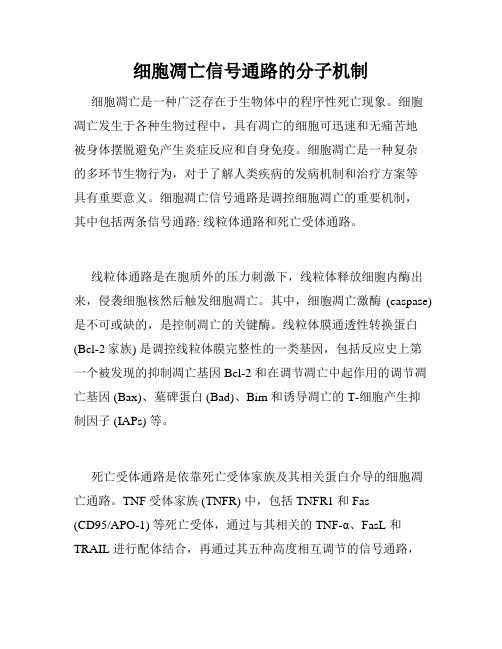
细胞凋亡信号通路的分子机制细胞凋亡是一种广泛存在于生物体中的程序性死亡现象。
细胞凋亡发生于各种生物过程中,具有凋亡的细胞可迅速和无痛苦地被身体摆脱避免产生炎症反应和自身免疫。
细胞凋亡是一种复杂的多环节生物行为,对于了解人类疾病的发病机制和治疗方案等具有重要意义。
细胞凋亡信号通路是调控细胞凋亡的重要机制,其中包括两条信号通路: 线粒体通路和死亡受体通路。
线粒体通路是在胞质外的压力刺激下,线粒体释放细胞内酶出来,侵袭细胞核然后触发细胞凋亡。
其中,细胞凋亡激酶(caspase) 是不可或缺的,是控制凋亡的关键酶。
线粒体膜通透性转换蛋白(Bcl-2家族) 是调控线粒体膜完整性的一类基因,包括反应史上第一个被发现的抑制凋亡基因 Bcl-2 和在调节凋亡中起作用的调节凋亡基因 (Bax)、墓碑蛋白 (Bad)、Bim 和诱导凋亡的 T-细胞产生抑制因子 (IAPs) 等。
死亡受体通路是依靠死亡受体家族及其相关蛋白介导的细胞凋亡通路。
TNF 受体家族 (TNFR) 中,包括 TNFR1 和 Fas(CD95/APO-1) 等死亡受体,通过与其相关的TNF-α、FasL 和TRAIL 进行配体结合,再通过其五种高度相互调节的信号通路,刺激及中介细胞内调节家族的调节因子激活,导致 caspase 活性、氧化应激、线粒体膜通透性等发生改变,从而使细胞凋亡。
细胞凋亡和存活之间的平衡是涉及细胞凋亡的调节,包含了一些因子的调节,其中包括蛋白激酶 A (PKA)、p53、骨钙素相关肽基因相关肽 (CGRP)、TNF-α 和口罩相关蛋白 (CFRP) 等。
p53 在许多细胞类型中发挥着重要作用,其调控了数百个基因,其中包括非细胞凋亡基因如 p21 和 Gadd45,以及与细胞凋亡有关的基因如 Bax、Fas/APO-1、PUMA 和 NOXA 等。
总的来说,细胞凋亡信号通路的分子机理非常复杂。
但是,通过探究细胞凋亡信号通路的分子机制,有利于了解许多疾病的发病机制和治疗方法,如肿瘤、免疫系统失调以及生殖障碍等。
细胞凋亡的信号通路及调控机制

细胞凋亡的信号通路及调控机制细胞凋亡是一种细胞程序性死亡的过程,是细胞自我毁灭的方式。
在多种细胞生命活动中,细胞凋亡不仅与正常组织的维持、裂变和修复密切相关,还参与了一系列脱落和细胞的抗肿瘤反应,因此其调节机制一直备受关注。
本文将介绍细胞凋亡的信号通路及调控机制。
一、细胞凋亡的一般过程细胞凋亡的通路复杂,核心是激活一系列蛋白酶称为Caspase,导致失去细胞组分、膜增墨及均匀的细胞体积缩小。
细胞凋亡还包括三个主要步骤:①特异性DNA断裂;②细胞核本身的形态与结构的改变;③因而引出细胞内和组织内细胞外信号通路上的多向交叉反应。
此外,细胞凋亡还通常分为两大类:胸腺型和酵母型。
胸腺型凋亡通常指依赖caspase活化以及成簇地整体的胞体细胞内和细胞外反应,酵母型凋亡由另一种非Caspase活化的机制控制。
二、细胞凋亡的信号通路1、Caspase信号通路Caspase是一种特异的半胱氨酸蛋白酶家族,它能在凋亡细胞中分解多种细胞因子等重要蛋白质,并诱导细胞凋亡。
Caspase有两个主要类型:前体酶和活化酶。
在毛细血管管壁中,破烈性和压力可能促使细胞内微信的Caspase活化。
受損壁细胞将产生膜钩,使Caspase自由起来,进入到胞内反应过程中,破坏胞的正常生理活动。
2、异位激酶受体信号通路异位激酶受体(TNFR)被活化后与FADD结合,形成死亡诱导信号复合体(DISC)。
FADD也促进了Caspase8和Caspase10的活化,从而归纳出了细胞凋亡。
TNFR启动的还有细胞程序性死亡依赖NF-KB(RELD)途径,可以抑制细胞凋亡和调节免疫功能。
3、钙离子信号通路哺乳动物几乎所有的细胞都能依赖钙离子浓度的动态变化来实现细胞生长、分化、分裂、细胞死亡和细胞骨架的重建。
钙离子信号通路不仅促进了游离钙离子的产生,还操纵了Ca2+进入内质网和细胞质,通过多种量子层面的调节实现了细胞生存与死亡的转换。
三、调控细胞凋亡的机制1、Bcl-2家族——调节细胞凋亡的一些重要蛋白Bcl-2家族成员共同参与细胞凋亡的调节。
基因调控在细胞凋亡中的作用

基因调控在细胞凋亡中的作用细胞死亡是细胞内部调控机制的一部分,并且是细胞周期的最终阶段。
凋亡,也称为“有序死亡”,是一种广泛存在于动物和植物生物中的程序性细胞死亡过程。
相比于坏死,凋亡具有明确的起始信号、前兆和特定的死亡表现,同时对周围环境没有负面影响。
如何调控细胞凋亡过程是一个重要的研究领域,其中基因调控在细胞凋亡中扮演了重要的角色。
基因调控是指细胞通过调控基因表达来控制其内部调控机制的过程。
细胞凋亡过程中,许多基因的表达发生了显著变化,从而控制了各种蛋白质的合成和分泌。
这些基因可以分为几类:先天免疫系统、细胞凋亡信号通路和炎症反应。
“信号通路”主要是指特定分子之间进行交互通讯的方式;“炎症反应”则指针对外部刺激引起的细胞反应,最终形成保护性反应。
先天免疫系统中的信号转导通路是调控凋亡的关键。
例如,在埃博拉病毒感染中,千百万人都受到了病毒的感染。
一项研究表明,与无症状感染者相比,患病者基因上出现了更多的免疫信号通道和炎症反应基因。
这些免疫基因支持先天免疫反应和炎症反应,从而形成对病毒的防御作用。
除了先天免疫系统外,细胞凋亡信号通路也是凋亡调控的重要一环。
由于各种内外因素的刺激,如DNA损伤、细胞过度增殖、病毒感染等,信号转导通路将会从诱导期转换到执行期,并开始产生凋亡程序。
凋亡调控主要通过JNK、p53、Bcl-2家族蛋白和Caspase信号通路来实现。
其中,Bcl-2家族蛋白是重要的凋亡调节基因家族。
Bcl-2家族共有25个成员,它们分为真核细胞活性基因(如Bcl-xL和Mcl-1)和真核细胞死亡基因(如Bax、Bid和Bad)。
这些基因通过调控线粒体膜的通透性来调控细胞凋亡。
线粒体膜通过表达外膜蛋白和内膜蛋白,产生并存储ATP、调节细胞体和细胞氧化还原状态,同时也可以调节细胞的凋亡程序。
PARP是蛋白解多聚酶(PARP)的缩写。
在细胞凋亡过程中,Bcl-2蛋白可以通过与PARP互动,直接或间接地、促进或抑制介导凋亡的某些蛋白酶,从而直接或间接地调控细胞凋亡过程。
细胞凋亡信号通路详细资料与总结

凋亡抑制剂
凋亡促进剂,与 BCL-2 和 BCL-XL 结合 线虫中的凋亡抑制剂,BCL-2 同源物 腺病毒凋亡抑制剂,与 Bax 和 Bak 结合
Bcl-2家族 引自Katja C. Zimmermann等2001
◆当 Caspase8 活化后,它一方面作用 Procaspase3,另一方面使Bid 裂解成 2 个片 段,其中含 BH3 结构域的 C-端片段被运送 到线粒体,与 Bcl-2/Bax 的 BH3 结构域形成 复合物,导致Cyt c释放。Cyt c 与胞质中 Ced4 同源物 Apaf-1(凋亡蛋白酶活化因子 apoptosis protease activating factor)结合并活 Apaf-1,活化的 Apaf-1 再活化Procaspase9, 最后引起细胞凋亡。
解 DNA。 –CAD 为caspase-activated Dnase(脱氧核苷酸酶),存在于胞质中。
细胞色素释 放引起的凋 亡(线粒体 凋亡通路)
死亡受体凋亡通路
fas 又称作 APO-1, TNFR( 肿瘤坏死因子受体)和 NGF 受体家族。 1993 年人白细胞分型国际会议统一命名为 CD95。 Fas 蛋白(受体)与 Fas 配体组成 Fas 系统,二者的 结合导致靶细胞走向凋亡。
信号转导研究方法
• 免疫共沉淀 • 荧光共振能量转移(FRET) • 荧光漂白恢复 • 荧光相关光谱 • 免疫荧光显微技术 • 电镜显微技术
◆ bcl-2 蛋白,是膜的整合蛋白,主要存在于线粒体外膜、核膜及部分内质 网中。
◆ Bcl-2家族成员都含有1-4个Bcl-2同源结构域(BH1-4),并且通常羧基末 端有一穿膜的结构域 (transmembrane region,TM)。其中BH4是抗凋亡蛋 白所特有的结构域,BH3是与促进凋亡有关的结构域。
细胞凋亡的相关信号通路解析
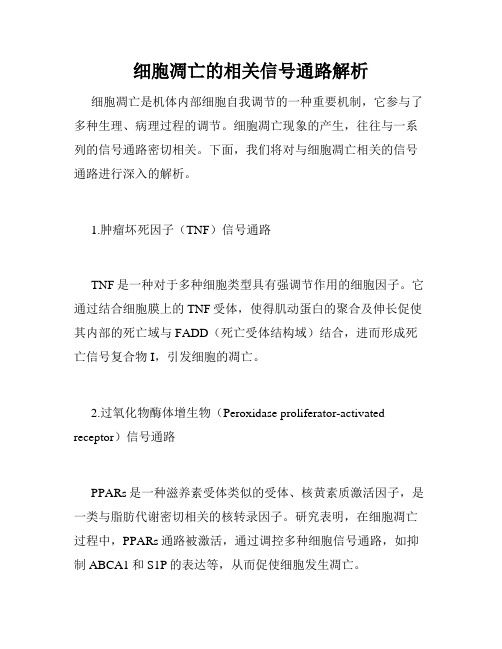
细胞凋亡的相关信号通路解析细胞凋亡是机体内部细胞自我调节的一种重要机制,它参与了多种生理、病理过程的调节。
细胞凋亡现象的产生,往往与一系列的信号通路密切相关。
下面,我们将对与细胞凋亡相关的信号通路进行深入的解析。
1.肿瘤坏死因子(TNF)信号通路TNF是一种对于多种细胞类型具有强调节作用的细胞因子。
它通过结合细胞膜上的TNF受体,使得肌动蛋白的聚合及伸长促使其内部的死亡域与FADD(死亡受体结构域)结合,进而形成死亡信号复合物I,引发细胞的凋亡。
2.过氧化物酶体增生物(Peroxidase proliferator-activated receptor)信号通路PPARs是一种滋养素受体类似的受体、核黄素质激活因子,是一类与脂肪代谢密切相关的核转录因子。
研究表明,在细胞凋亡过程中,PPARs通路被激活,通过调控多种细胞信号通路,如抑制ABCA1和S1P的表达等,从而促使细胞发生凋亡。
3.磷脂酸信号转导通路磷脂酸信号转导通路包括红细胞Xe-63磷酸酰肌醇3激酶(PI3K)、蛋白激酶B(AKT)等信号分子,能够介导细胞的增殖、存活、分化及凋亡。
在细胞凋亡过程中,PI3K/AKT通路可能会被抑制或者受损,从而加速细胞的凋亡。
4.线粒体途径线粒体途径是细胞凋亡的常见途径。
在细胞凋亡过程中,半胱氨酸蛋氨酸酰化酶(Caspase)能够调控线粒体的膜电位和导致损伤,从而导致线粒体的释放,释放出的线粒体产生信号分子,如细胞色素c、APOPT1等,进而启动细胞凋亡的程序。
5.特异性脂肪肝X受体(FXR)信号通路FXR是一种与肝脏疾病相关的核受体,研究表明,FXR信号通路与细胞凋亡密切相关。
FXR同样可以促进细胞凋亡,同时也可以在细胞死亡后通过TGFB信号通路来调控细胞的再生。
在总结上述的信号通路之后,我们可以发现,这些信号通路都是通过调控多种细胞分子,如结构蛋白、酶和膜蛋白的功能来达到调控细胞凋亡的目的的。
同时,这些不同的信号通路之间也有很多相互作用,相互影响的关系。
凋亡的相关蛋白指标
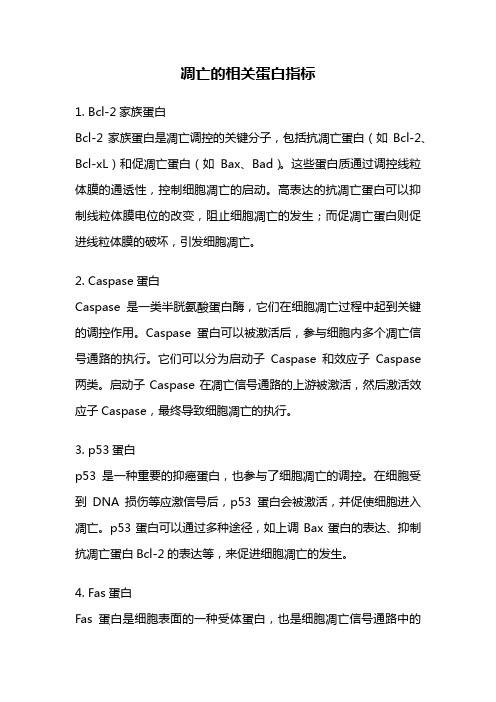
凋亡的相关蛋白指标1. Bcl-2家族蛋白Bcl-2家族蛋白是凋亡调控的关键分子,包括抗凋亡蛋白(如Bcl-2、Bcl-xL)和促凋亡蛋白(如Bax、Bad)。
这些蛋白质通过调控线粒体膜的通透性,控制细胞凋亡的启动。
高表达的抗凋亡蛋白可以抑制线粒体膜电位的改变,阻止细胞凋亡的发生;而促凋亡蛋白则促进线粒体膜的破坏,引发细胞凋亡。
2. Caspase蛋白Caspase是一类半胱氨酸蛋白酶,它们在细胞凋亡过程中起到关键的调控作用。
Caspase蛋白可以被激活后,参与细胞内多个凋亡信号通路的执行。
它们可以分为启动子Caspase和效应子Caspase 两类。
启动子Caspase在凋亡信号通路的上游被激活,然后激活效应子Caspase,最终导致细胞凋亡的执行。
3. p53蛋白p53是一种重要的抑癌蛋白,也参与了细胞凋亡的调控。
在细胞受到DNA损伤等应激信号后,p53蛋白会被激活,并促使细胞进入凋亡。
p53蛋白可以通过多种途径,如上调Bax蛋白的表达、抑制抗凋亡蛋白Bcl-2的表达等,来促进细胞凋亡的发生。
4. Fas蛋白Fas蛋白是细胞表面的一种受体蛋白,也是细胞凋亡信号通路中的一个重要分子。
当Fas受体与其配体结合时,会激活Caspase蛋白的级联反应,最终导致细胞凋亡。
Fas蛋白的异常表达与多种疾病的发生和发展密切相关,如肿瘤的恶性转移、自身免疫性疾病等。
5. c-Jun N端激酶(JNK)蛋白JNK是一种丝裂原活化蛋白激酶,参与了细胞凋亡的调控。
JNK蛋白可以被多种刺激因子激活,如细胞应激、DNA损伤等。
激活的JNK蛋白可以通过磷酸化下游靶蛋白,如Bcl-2蛋白家族成员,来促进细胞凋亡的发生。
以上所提到的凋亡相关蛋白指标只是凋亡调控网络中的一部分,还有许多其他蛋白质也参与了细胞凋亡的调控。
了解这些蛋白质的功能和相互作用对于深入研究细胞凋亡的机制以及相关疾病的治疗具有重要意义。
随着科学技术的不断进步,对凋亡相关蛋白指标的研究也将进一步深入,为未来的治疗手段提供更多可能性。
caspase信号通路讲解

Caspase蛋白酶在死亡受体介导的细胞凋亡中起着中心的作用
1. Fas与配体结合而活化后, 2. 引起YVAD和zVAD敏感 的ICE家族蛋白酶活化, 3. 活化DEVD敏感的蛋白酶。 其中caspase-8是这一凋 亡过程中首先被活化的 ICE家族蛋白酶。 4. Caspase-8活化后, ① 剪切活化caspase-3、 caspase-7、 caspase-4、 caspase-9和 caspase-10,通过 这些蛋白酶剪切底物 使凋亡得以进行; ② 活性被CrmA所抑制, 籍此可作为细胞凋亡 负调控因素作用的环 节。
Caspase家族蛋白酶的识别序列及作用底物
蛋白酶 caspase 1 caspase 4 caspase 5 mICH3 mICH4 caspase 2 caspase 9 caspase 3 caspase 6 caspase 7 caspase 8 caspase 10 caspase 11 CED-3 别名 ICE TX, ICH-2, ICErel-II ICErel-III, TY 序列 底物 YVAD pro-IL-1b , pro-caspase 3, pro-caspase 4 pro-caspase 1
Caspase-2:
细胞发生凋亡时,48kDa的caspase-2先被一种caspase-3样蛋白酶在Asp316 剪切成p33和p14,然后再缓慢地在Asp152和Asp330处剪切为p18和p12组成的 活性蛋白酶,后一过程要在2~3h后才能完成。caspase-2可能参与CTL细胞的杀 伤作用,但它并不能被颗粒酶B直接活化,必须被一种caspase-3样蛋白酶活化。
Caspase家族蛋白酶的结构特征
Caspase家族蛋白酶的同源性 Caspase-1亚族:
caspase信号通路

细胞外途径:
细胞死亡信号蛋白盘 绕粘附到它的同源细 胞表面接收器上,死 亡配体与其受体结合, 导致其死亡结构域相 互积聚,并与转接器 分子的死亡结构域相 互结合,使死亡受体 分子活化。导致细胞 内pro- caspase 局 部聚集,FADD与募 集的pro- caspase 8地DED(长原域中 包含的死亡效应域结 合形成信号复合物, 使pro- caspase -8 自我水解、活化,形 成活性caspase -8。 激活的caspase -8激 活下游caspase,引 起细胞凋亡。
2. 当信号分子是多肽时:只能与细胞膜上的蛋白质等受体结合,这些受体大都 是跨膜蛋白,通过构象变化,将信号从膜外域传到膜内域,然后再与下一级 别受体作用,通过磷酸化等修饰化激活下一级别通路。
接收
转导
效应
Caspase
信号通 路
细胞外途径
细胞内途径
细胞内途径:
由线粒体介导的内源 性凋亡通路是哺乳动 物细胞程序性死亡的 主要途径。 凋亡刺激-死亡促进因 子(DPF),包括细 胞色素C、凋亡诱导 因子(AIF)、促死 亡蛋白、 caspase酶 原的释放-dATP、 ATP存在下活化 caspase-细胞凋亡。
在正常的细胞内,每一种caspase都是以非活性状态存在的,这种非活 性的caspase称作酶原(zymogen),它是酶的非活性前体,其肽链 比有活性时长一些,将多出的部分切除,就转变成有活性的caspase。
Caspase家族
Caspase家族蛋白酶的识别序列及作用底物 Casቤተ መጻሕፍቲ ባይዱase家族蛋白酶的结构特征 Caspase家族蛋白酶的同源性 Caspase蛋白酶在细胞凋亡中的活化顺序 Caspase蛋白酶在死亡受体介导的细胞凋亡 中起着中心的作用 Caspase蛋白酶家族
caspase信号通路详解
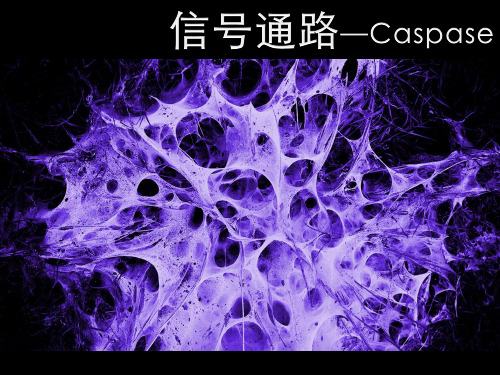
信号通路(signal pathway) : 分类:
当细胞里要发生某种反应时,信号从细胞外到细胞内传递了一种信息,细胞要根 据这种信息来做出反应的现象,叫做信号通路。
1. 当信号分子是胆固醇等脂质时:可以轻易穿过细胞膜,在细胞质内与目的受 体相结合; 2. 当信号分子是多肽时:只能与细胞膜上的蛋白质等受体结合,这些受体大都 是跨膜蛋白,通过构象变化,将信号从膜外域传到膜内域,然后再与下一级 别受体作用,通过磷酸化等修饰化激活下一级别通路。
Caspase家族蛋白酶的识别序列及作用底物
蛋白酶 caspase 1 caspase 4 caspase 5 mICH3 mICH4 caspase 2 caspase 9 caspase 3 caspase 6 caspase 7 caspase 8 caspase 10 caspase 11 CED-3 别名 ICE TX, ICH-2, ICErel-II ICErel-III, TY 序列 底物 YVAD pro-IL-1b , pro-caspase 3, pro-caspase 4 pro-caspase 1
在正常的细胞内,每一种caspase都是以非活性状态存在的,这种非活性 的caspase称作酶原(zymogen),它是酶的非活性前体,其肽链比有活 性时长一些,将多出的部分切除,就转变成有活性的caspase。
Caspase家族蛋白酶的识别序列及作用底物
Caspase家族蛋白酶的结构特征 Caspase家族蛋白酶的同源性 Caspase蛋白酶在细胞凋亡中的活化顺序 Caspase蛋白酶在死亡受体介导的细胞凋亡 中起着中心的作用 Caspase蛋白酶家族
caspass1通路调控机制
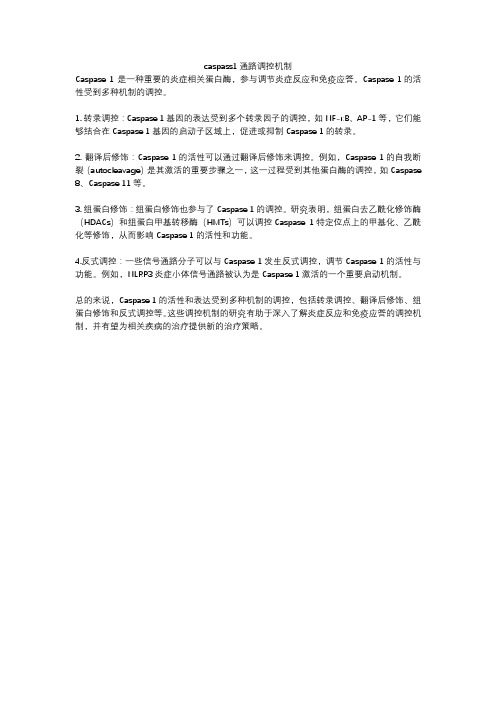
caspass1通路调控机制
Caspase 1 是一种重要的炎症相关蛋白酶,参与调节炎症反应和免疫应答。
Caspase 1的活性受到多种机制的调控。
1. 转录调控:Caspase 1基因的表达受到多个转录因子的调控,如NF-κB、AP-1等,它们能够结合在Caspase 1基因的启动子区域上,促进或抑制Caspase 1的转录。
2. 翻译后修饰:Caspase 1的活性可以通过翻译后修饰来调控。
例如,Caspase 1的自我断裂(autocleavage)是其激活的重要步骤之一,这一过程受到其他蛋白酶的调控,如Caspase 8、Caspase 11等。
3. 组蛋白修饰:组蛋白修饰也参与了Caspase 1的调控。
研究表明,组蛋白去乙酰化修饰酶(HDACs)和组蛋白甲基转移酶(HMTs)可以调控Caspase 1特定位点上的甲基化、乙酰化等修饰,从而影响Caspase 1的活性和功能。
4.反式调控:一些信号通路分子可以与Caspase 1发生反式调控,调节Caspase 1的活性与功能。
例如,NLRP3炎症小体信号通路被认为是Caspase 1激活的一个重要启动机制。
总的来说,Caspase 1的活性和表达受到多种机制的调控,包括转录调控、翻译后修饰、组蛋白修饰和反式调控等。
这些调控机制的研究有助于深入了解炎症反应和免疫应答的调控机制,并有望为相关疾病的治疗提供新的治疗策略。
细胞凋亡途径的调控和信号传导

细胞凋亡途径的调控和信号传导细胞凋亡是一种细胞自我消亡的过程,通常与生长、发育和维护机体稳态的调节相关。
细胞凋亡的途径很复杂,包括内源性和外源性两种途径。
1. 内源性凋亡途径内源性凋亡途径是指由于内源性因素引起的细胞内部代谢失衡,导致凋亡发生。
人体细胞会释放细胞因子,通过调节自身信号传导通路来正常分裂或死亡。
但是,由于某些损伤或刺激,细胞内部环境受到了干扰,导致细胞凋亡。
细胞凋亡的内源性途径主要包括线粒体途径、蛋白酶途径和内质网途径。
其中,线粒体途径又称为凋亡信号放大器途径,发挥了细胞凋亡途径中的至关重要的作用。
线粒体途径受到的刺激可以引起过氧化物酶酶体水平的上升,导致细胞氧化应激,并导致线粒体膜电势决定性的下降和线粒体膜通透性过高。
线粒体向细胞质释放出凋亡因子Cyt c和海绵蛋白AIF等,触发一系列的结构性变化和信号传导。
2. 外源性凋亡途径外源性凋亡途径是指细胞对外部刺激、病毒感染等因素引起细胞死亡的过程。
外源性凋亡途径受到的刺激可以触发凋亡原受体FasL/FasR途径和Toll样受体途径等封装体系,导致下游信号传导的激活。
外源性凋亡途径因其受到许多外部因素的调节,使得其发生的机制更加复杂。
3. 记忆性凋亡路线在细胞凋亡过程中,细胞被激活并且记忆了一段时间的生存和较为平稳运转的状态,这样,即使当前生命能量需要的供应有所减少,由于有记忆性凋亡路线存在,这类细胞也不会继续生命周期的正常秩序,而是选择进入凋亡状态。
4. 信号传导细胞凋亡途径中的信号传导复杂且多样,许多信号都可以控制凋亡途径。
细胞内信号途径包括Caspase途径、Akt途径、MAPK 途径等等。
Caspase途径是凋亡途径中最重要的信号通路之一,参与细胞凋亡的执行者Caspase-3、Caspase-7、Caspase-8以及Caspase-9的激活与调控,也被广泛研究。
此外,MAPK途径和Akt途径分别在凋亡途径中发挥了关键性的作用,MAPK途径通过增加Bax/Bcl-2比例发挥了作用,而Akt途径则通过FasL/FasR途径发挥作用。
细胞焦亡信号通路
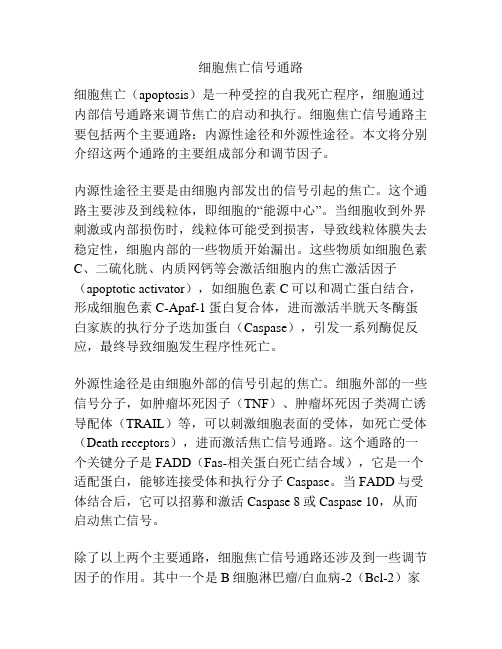
细胞焦亡信号通路细胞焦亡(apoptosis)是一种受控的自我死亡程序,细胞通过内部信号通路来调节焦亡的启动和执行。
细胞焦亡信号通路主要包括两个主要通路:内源性途径和外源性途径。
本文将分别介绍这两个通路的主要组成部分和调节因子。
内源性途径主要是由细胞内部发出的信号引起的焦亡。
这个通路主要涉及到线粒体,即细胞的“能源中心”。
当细胞收到外界刺激或内部损伤时,线粒体可能受到损害,导致线粒体膜失去稳定性,细胞内部的一些物质开始漏出。
这些物质如细胞色素C、二硫化胱、内质网钙等会激活细胞内的焦亡激活因子(apoptotic activator),如细胞色素C可以和凋亡蛋白结合,形成细胞色素C-Apaf-1蛋白复合体,进而激活半胱天冬酶蛋白家族的执行分子迭加蛋白(Caspase),引发一系列酶促反应,最终导致细胞发生程序性死亡。
外源性途径是由细胞外部的信号引起的焦亡。
细胞外部的一些信号分子,如肿瘤坏死因子(TNF)、肿瘤坏死因子类凋亡诱导配体(TRAIL)等,可以刺激细胞表面的受体,如死亡受体(Death receptors),进而激活焦亡信号通路。
这个通路的一个关键分子是FADD(Fas-相关蛋白死亡结合域),它是一个适配蛋白,能够连接受体和执行分子Caspase。
当FADD与受体结合后,它可以招募和激活Caspase 8或Caspase 10,从而启动焦亡信号。
除了以上两个主要通路,细胞焦亡信号通路还涉及到一些调节因子的作用。
其中一个是B细胞淋巴瘤/白血病-2(Bcl-2)家族蛋白。
Bcl-2家族中的一些成员,如Bcl-2、Bax、Bcl-xL等,能够调节线粒体的膜通透性,进而控制焦亡信号的发出。
Bcl-2和Bcl-xL可以抑制线粒体膜的通透性,从而抑制线粒体的膜潜降低,减少细胞内的焦亡激活因子的释放。
而Bax等蛋白则促进线粒体膜的通透性,有助于焦亡信号的传递。
另一个重要的调节因子是NF-κB(核因子-κB)。
钙离子信号在细胞生物学中的研究进展
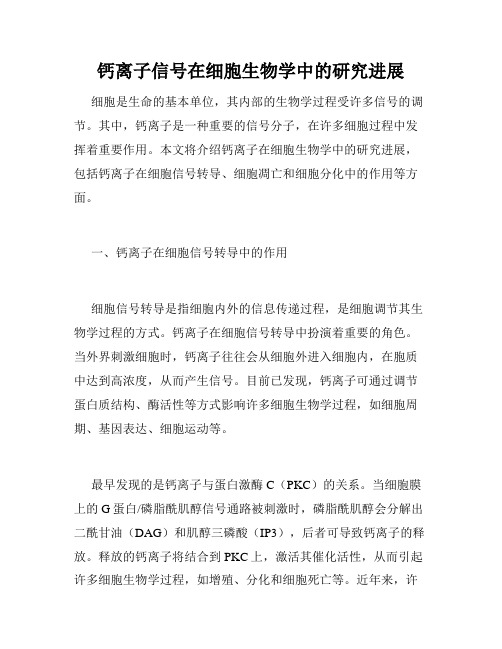
钙离子信号在细胞生物学中的研究进展细胞是生命的基本单位,其内部的生物学过程受许多信号的调节。
其中,钙离子是一种重要的信号分子,在许多细胞过程中发挥着重要作用。
本文将介绍钙离子在细胞生物学中的研究进展,包括钙离子在细胞信号转导、细胞凋亡和细胞分化中的作用等方面。
一、钙离子在细胞信号转导中的作用细胞信号转导是指细胞内外的信息传递过程,是细胞调节其生物学过程的方式。
钙离子在细胞信号转导中扮演着重要的角色。
当外界刺激细胞时,钙离子往往会从细胞外进入细胞内,在胞质中达到高浓度,从而产生信号。
目前已发现,钙离子可通过调节蛋白质结构、酶活性等方式影响许多细胞生物学过程,如细胞周期、基因表达、细胞运动等。
最早发现的是钙离子与蛋白激酶C(PKC)的关系。
当细胞膜上的G蛋白/磷脂酰肌醇信号通路被刺激时,磷脂酰肌醇会分解出二酰甘油(DAG)和肌醇三磷酸(IP3),后者可导致钙离子的释放。
释放的钙离子将结合到PKC上,激活其催化活性,从而引起许多细胞生物学过程,如增殖、分化和细胞死亡等。
近年来,许多研究表明,钙离子还能通过其他途径参与信号转导,如通过细胞膜钙离子通道、质膜转运、内质网和线粒体等渠道进入细胞质,进而影响细胞生物学过程。
在未来,我们有必要全面了解钙离子在这些途径中的作用,以期更准确地掌握细胞信号转导的调节机制。
二、钙离子在细胞凋亡中的作用细胞凋亡是一种程序性细胞死亡方式,是维持生态平衡的重要方式之一。
可以看作是一种钙离子介导的程序性细胞死亡方式。
近年来的研究表明,钙离子可通过几条途径引发细胞凋亡发生,如调节半胱氨酸蛋白酶(Caspase)和蛋白激酶等关键性质的活性,影响线粒体膜平衡,并影响细胞死亡相关的基因表达。
在这些途径中,钙离子通过Caspase信号通路的作用较为突出。
Caspase是钙离子介导的一类重要蛋白质,能够调节蛋白质的降解,使细胞发生凋亡。
近年来的研究表明,钙离子可通过CaMKII、CaMKIV等激酶的作用促进Caspase的活性,从而引发细胞凋亡。
细胞凋亡的原理及不同信号通路
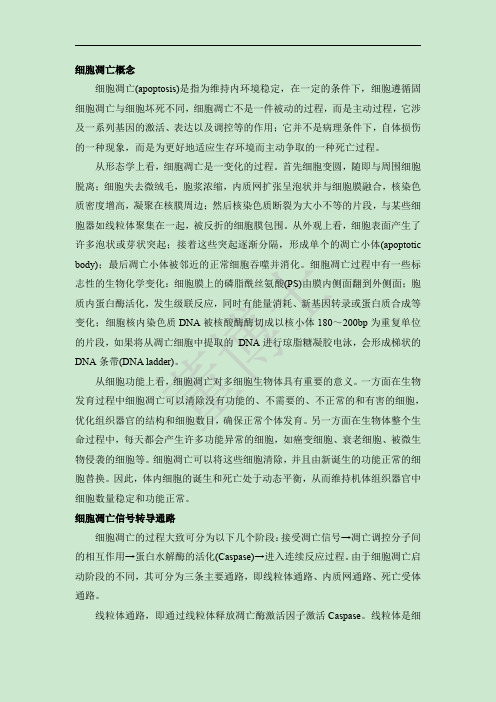
细胞凋亡概念细胞凋亡(apoptosis)是指为维持内环境稳定,在一定的条件下,细胞遵循固细胞凋亡与细胞坏死不同,细胞凋亡不是一件被动的过程,而是主动过程,它涉及一系列基因的激活、表达以及调控等的作用;它并不是病理条件下,自体损伤的一种现象,而是为更好地适应生存环境而主动争取的一种死亡过程。
从形态学上看,细胞凋亡是一变化的过程。
首先细胞变圆,随即与周围细胞脱离;细胞失去微绒毛,胞浆浓缩,内质网扩张呈泡状并与细胞膜融合,核染色质密度增高,凝聚在核膜周边;然后核染色质断裂为大小不等的片段,与某些细胞器如线粒体聚集在一起,被反折的细胞膜包围。
从外观上看,细胞表面产生了许多泡状或芽状突起;接着这些突起逐渐分隔,形成单个的凋亡小体(apoptotic body);最后凋亡小体被邻近的正常细胞吞噬并消化。
细胞凋亡过程中有一些标志性的生物化学变化:细胞膜上的磷脂酰丝氨酸(PS)由膜内侧面翻到外侧面;胞质内蛋白酶活化,发生级联反应,同时有能量消耗、新基因转录或蛋白质合成等变化;细胞核内染色质DNA被核酸酶酶切成以核小体180~200bp为重复单位的片段,如果将从凋亡细胞中提取的DNA进行琼脂糖凝胶电泳,会形成梯状的DNA条带(DNA ladder)。
从细胞功能上看,细胞凋亡对多细胞生物体具有重要的意义。
一方面在生物发育过程中细胞凋亡可以清除没有功能的、不需要的、不正常的和有害的细胞,优化组织器官的结构和细胞数目,确保正常个体发育。
另一方面在生物体整个生命过程中,每天都会产生许多功能异常的细胞,如癌变细胞、衰老细胞、被微生物侵袭的细胞等。
细胞凋亡可以将这些细胞清除,并且由新诞生的功能正常的细胞替换。
因此,体内细胞的诞生和死亡处于动态平衡,从而维持机体组织器官中细胞数量稳定和功能正常。
细胞凋亡信号转导通路细胞凋亡的过程大致可分为以下几个阶段:接受凋亡信号→凋亡调控分子间的相互作用→蛋白水解酶的活化(Caspase)→进入连续反应过程。
泛凋亡激活机制

泛凋亡激活机制
泛凋亡激活机制是一种细胞自我保护机制,它可以在细胞受到外界刺激或内部损伤时,通过一系列信号传递和调节,引发细胞凋亡,从而保护整个组织或器官的健康。
在正常情况下,细胞会通过自我修复和再生来保持其正常功能。
但是,当细胞受到外界刺激或内部损伤时,如DNA损伤、氧化应激、病毒感染等,细胞就会启动泛凋亡激活机制,以保护整个组织或器官的健康。
泛凋亡激活机制的启动需要一系列信号传递和调节。
首先,细胞内部会产生一些信号分子,如TNF、FasL等,它们会与细胞表面的受体结合,形成信号复合物。
这个信号复合物会激活一系列信号通路,如caspase信号通路、mitochondrial信号通路等,最终导致细胞凋亡。
在这个过程中,caspase信号通路是最为重要的。
它包括两个阶段:启动阶段和执行阶段。
在启动阶段,信号复合物会激活caspase-8,这个酶会进一步激活caspase-3和caspase-7,最终导致细胞凋亡。
在执行阶段,caspase-3和caspase-7会切割一系列细胞内的蛋白质,如核蛋白、细胞骨架等,最终导致细胞死亡。
除了caspase信号通路外,mitochondrial信号通路也是泛凋亡激活机制的重要组成部分。
在这个信号通路中,细胞内部的线粒体会
释放一些信号分子,如细胞色素c、AIF等,这些信号分子会激活caspase-9,最终导致细胞凋亡。
泛凋亡激活机制是一种重要的细胞自我保护机制,它可以在细胞受到外界刺激或内部损伤时,引发细胞凋亡,从而保护整个组织或器官的健康。
对于疾病的治疗和预防,研究泛凋亡激活机制具有重要的意义。
- 1、下载文档前请自行甄别文档内容的完整性,平台不提供额外的编辑、内容补充、找答案等附加服务。
- 2、"仅部分预览"的文档,不可在线预览部分如存在完整性等问题,可反馈申请退款(可完整预览的文档不适用该条件!)。
- 3、如文档侵犯您的权益,请联系客服反馈,我们会尽快为您处理(人工客服工作时间:9:00-18:30)。
Caspases are a family of cysteine proteases that act in concert in a cascade triggered by apoptosis signaling. The culmination of this cascade is the cleavage of a number of proteins in the cell, followed by cell disassembly, cell death, and, ultimately, the phagocytosis and removal of the cell debris. The Caspase cascade is activated by two distinct routes: one from cell surface and the other from mitochondria (Ref.1). The pathway leading to Caspase activation varies according to the apoptotic stimulus. Initiator Caspases (including 8, 9, 10 and 12) are closely coupled to pro-apototic signals. Pro-apoptotic stimuli include the FasL (Fas Ligand), TNF (Tumor Necrosis Factor), Granzyme-B, GRB (Growth Factor Receptor-Bound Protein), DNA damage, Ca2+ (Calcium) channels and ER (Endoplasmic Reticulum) stress. Once activated, these Caspases cleave and activate downstream effector Caspases (including 3, 6 and 7). Caspase8 cleaves BID (BH3 Interacting Death Domain). tBID (Truncated BID) disrupts the outer mitochondrial membrane to cause release of the pro-apoptotic factors CytoC (Cytochrome-C) which is crucial for activating pro-Caspase9. CytoC that is released from the intermembrane space binds to APAF1 (Apoptotic Protease Activating Factor-1), which recruits Caspase9 and in turn can proteolytically activate Caspase3. SMAC (Second Mitochondria-Derived Activator of Caspase)/DIABLO is also released from the mitochondria along with CytoC during apoptosis, and it functions to promote caspase activation by inhibiting IAP (Inhibitor of Apoptosis) family proteins. ER stress leads to the Ca2+-mediated activation of Caspase12 (Ref.2).Fas and the TNFR (TNF Receptor) activate Caspases8 and 10. Cell death caused by activation of the TNFR or Fas receptors is brought about by the recruitment of the adaptor protein FADD (Fas Associated Death Domain). In the case of the TNFR1, FADD recruitment requires prior binding of TRADD (TNFR-Associated Death Domain Protein). FADD in turn recruits ProCaspase8. The TNFR1 receptor can also mediate activation of Caspase2 via the recruitment of a death-inducing signaling complex. In this case RIP (Receptor-Interacting Protein) acts as an adaptor for the recruitment of RAIDD (RIP-AssociatedICH-1/CED-3-homologous protein with a Death Domain), which subsequently binds to ProCaspase2. TNFR also activates Caspase3, 6,7 via TRADD, TRAF2 (TNF Receptor-Associated Factor-2) and RICK (RIP-like Interacting Clarp Kinase). TNF not only induces apoptosis by activating Caspase8 and 10, but can also inhibit apoptosis signaling via NF-KappaB (Nuclear Factor-KappaB), which induces the expression of IAP, an inhibitor of Caspases3, 7 and 9 (Ref.3).GRB (Growth Factor Receptor-Bound Protein), Granzyme B and perforin proteins released by cytotoxic T-Cells induce apoptosis in target cells, forming transmembrane pores, and triggering apoptosis, perhaps through cleavage of Caspases, although Caspase-independent mechanisms of Granzyme-B mediated apoptosis have been suggested (Ref.4). After activation, down stream Caspases cleave cytoskeletal and nuclear proteins (structural, signaling proteins or kinases) like PARP (Poly ADP-Ribose Polymerase), DNA-PK (DNA-Dependent Protein Kinase), Rb (Retino Blastoma Tumor Supressor Protein), PAK1 (p21-Activated Kinase-1), GDID4, Fodrin, Lamin-A, Lamin-B1, Lamin-B2, thus inducing apoptosis. Caspase3 cleaves ICAD (Inhibitor of CAD) to free CAD (Caspase-Activated DNase) to cause DNA fragmentation. The events culminating in Caspase activation and the subsequent disassembly of the cell are the subject of intense study because of their role in many neurodegenerative disorders such as Parkinson's and Alzheimer’s diseases, autoimmune disorders, and tumorigenesis.References:1. Srinivasula SM,Ahmad M,Fernandes-Alnemri T,Alnemri ES.Autoactivation of procaspase-9 by Apaf-1-mediated oligomerization.Mol Cell. 1998 Jun;1(7):949-57.2. Pirnia F,Schneider E,Betticher DC,Borner MM.Mitomycin C induces apoptosis and caspase-8 and -9 processing through a caspase-3 and Fas-independentpathway.Cell Death Differ. 2002 Sep;9(9):905-14.3. Swanton E,Savory P,Cosulich S,Clarke P,Woodman P.Bcl-2 regulates a caspase-3/caspase-2 apoptotic cascade in cytosolic extracts.Oncogene. 1999 Mar 11;18(10):1781-7.4. Pinkoski MJ,Heibein JA,Barry M,Bleackley RC.Nuclear translocation of granzyme B in target cell apoptosis.Cell Death Differ. 2000 Jan;7(1):17-24.。
